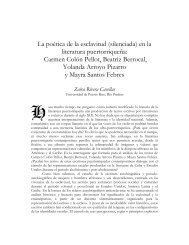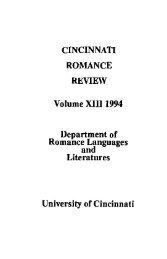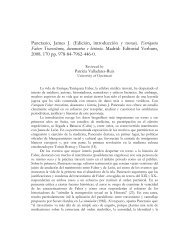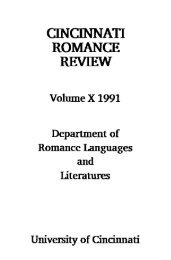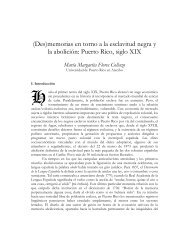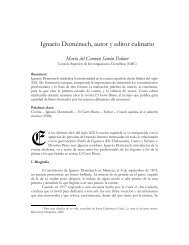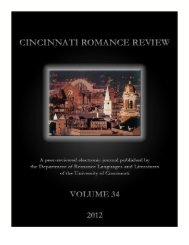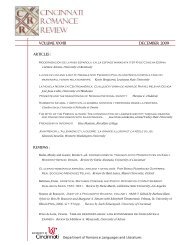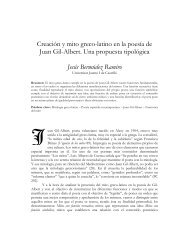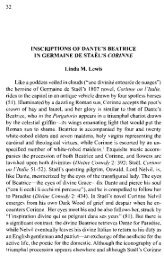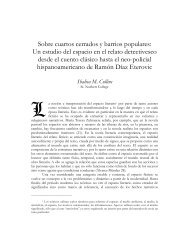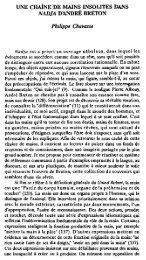Volume 30 (2011) - Cincinnati Romance Review
Volume 30 (2011) - Cincinnati Romance Review
Volume 30 (2011) - Cincinnati Romance Review
You also want an ePaper? Increase the reach of your titles
YUMPU automatically turns print PDFs into web optimized ePapers that Google loves.
“DOUBLE CONSCIOUSNESS/DOUBLE BIND” 75<br />
The poet-speaker ends the poem with the most violent act of men against women: that<br />
of the physical violation of women.<br />
Hoy, quiero ser un hombre. Subir por las tapias,<br />
burlar los conventos, ser todo un Don Juan;<br />
raptar a Sor Carmen y a Sor Josefina,<br />
rendirlas, y a Julia de Burgos violar. (26)<br />
Julia de Burgos satirizes one of the most powerful figures in Spanish literature,<br />
that of El Quijote. The tone is burlesque and clearly mocks the sexual prowess of men.<br />
The poet-speaker ends with the violation of author Julia de Burgos. By inserting herself<br />
in the text, she rewrites literary history and subverts and dismantles the power of men.<br />
Through the literary tropes of subversion and satire, de Burgos found a subtle way to be<br />
voiced. Clearly, it is only through poetry and writing that women can achieve revenge.<br />
“Ay, ay, ay de la grifa negra” displays a mulata consciousness and treats the<br />
question of race and gender. Julia de Burgos writes both within the negrista tradition and<br />
against it by conforming to and deconstructing national myths about blacks. The poem<br />
commences,<br />
Ay, ay, ay, que soy grifa y pura negra;<br />
grifería en mi pelo, cafrería en mis labios;<br />
y mi chata nariz mozambiquea. (32)<br />
The first stanza is reminiscent of negrista literature dominated by white writers<br />
who characterized blacks stereotypically as big-lipped. Even some black writers utilized<br />
stereotypical caricatures to portray blacks as evidenced in the above cited poem and in<br />
Nicolás Guillén’s “Negro bembón” which satirizes a big-lipped black man who lives off<br />
the hard work of others. However, in “Ay, ay, ay de la grifa negra” the burlesque tone<br />
changes in the third stanza of the poem and chastises the slave masters for their lack of<br />
moral and social conscious:<br />
Dícenme que mi abuelo fue el esclavo<br />
por quien el amo dio treinta monedas.<br />
Ay, ay, ay, que el esclavo fue mi abuelo<br />
es mi pena, es mi pena.<br />
Si hubiera sido el amo,<br />
sería mi vergüenza;<br />
que en los hombres, igual que en las naciones,<br />
si el ser el siervo es no tener derechos,<br />
el ser el amo es no tener conciencia. (32)<br />
<strong>Cincinnati</strong> <strong>Romance</strong> <strong>Review</strong> <strong>30</strong> (Winter <strong>2011</strong>): 69-82.



